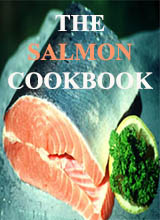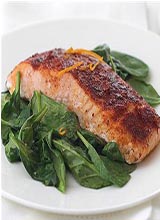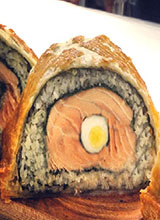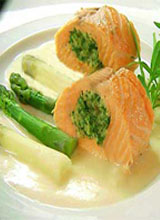Steelhead, Steelhead trout, or sea-run rainbow trout
Steelhead are the anadromous form of rainbow trout. Their common names comes from the steel-blue color of the head, especially when in salt water. The general body coloration is metallic-blue on dorsal surfaces, silvery on the sides and belly, with black spots on the dorsal and caudal fins. The spots are less distinct in salt water or fresh from the sea. Adults, particularly males, darken in fresh water as they approach spawning and develop the characteristic rainbow trout pink/red band along their sides and pink coloration on the opercles (gill covers). Juvenile steelhead can be differentiated from coastal cutthroat by their shorter head, compressed body, absence of teeth on the back of the tongue, absence of a red slash below the lower jaw and lighter edges on the dorsal, anal, and pelvic fins. Rainbow and steelhead usually have 11 or 12 (range 9 - 11) in cutthroat.
The Silver Ghosts Steelhead are similar to other Pacific salmon in many ways but for one glaring exception: they can be repeat spawners (as are Cutthroat trout). Their classification is hotly debated: they used to be placed in the genus Salmo (like Atlantic salmon); now most scientists place them in the Oncorhynchus genus, while others disagree because of their repeat spawning. Whatever their genus, Steelhead are most likely to be found in eastern Pacific waters. Unlike Pacific salmon, which die after spawning once, steelhead can spawn multiple times during their lives, each time returning to the ocean and back to their home rivers. They live up to eight years! Steelhead can spawn three times, but most don't survive that long (especially males). The largest Steelhead can weigh over 30 lbs and measure 45 inches, but most weigh between eight and 20 lbs. A Non-Anadromous Variation: Rainbow Trout. As Sockeye have a freshwater-only variation, the Kokannee, Steelhead have the Rainbow trout, who never see the ocean. There are six sub-species of Rainbow trout in the Pacific Rim. Spotting a Steelhead The less time they spend in freshwater, or the more recent their stay in the ocean, the more Steelhead take on the traditional Pacific salmon colouring of dark blue backs with spots and silvery sides. The lengthier a freshwater stay, the more a Steelhead looks like a Rainbow trout: silvery and bright with tints of orange and pinks running through the scales. The Long-Distance Runners: Kelts Steelhead that have spawned and make it successfully back to the ocean are called kelts. When they begin the difficult journey to the ocean after spawning, they are emaciated and weak from the exertions of spawning. Kelts return to the ocean for up to a year before returning to spawn again. Habits and Habitat Steelhead stay in freshwater for one to three years before making their way to the ocean. As they become older, they prefer cold, deep pools and are particularly reliant on shade to keep the slower moving water in these locations cool. Some Steelhead return from the ocean during November to May ("winter-run" Steelhead) at the age of four or five, while other younger Steelhead (aged three) will enter freshwater between April and October ("summer-run" Steelhead). Winter and summer Steelhead are considered different races, though they both spawn between January to May and often share the same stream or river. Other Facts About Steelhead: Steelhead and Rainbow trout are closely related from a genetic standpoint. In fact, if environmental conditions (such as drought or habitat destruction) force the issue, Steelhead can give up their ocean-going ways and stay in freshwater. Steelhead are at risk of extinction in many areas of the Pacific Rim.




The Salmon Cookbook - Everything You Need to Know + 168 Recipes
Upon purchase, the book is immediately available to download and save to your PC, tablet or smartphone in PDF format (Adobe Acrobat, iBooks).
© 2025 Copyright by The Salmon Cookbook. All Rights Reserved.
